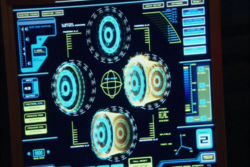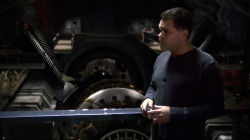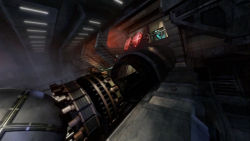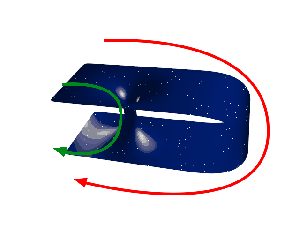Propulsion in the Re-imagined Series
More languages
More actions
- For information on the Original Series' modes of propulsion, see Propulsion (TOS).
| An article from |
In the Re-imagined Series, propulsion systems are powered by fuel refined from tylium ore. A ship's primary propulsion systems, referred to as "sublight engines", allow it to travel at a slight fraction of the speed of light, which is sufficient to traverse the distances between planets in a solar system in relatively short timeframes. Most ships in the series also have a secondary system, called a faster-than-light drive (or "FTL"), that enables a ship to travel interstellar distances almost instantaneously, by "folding up space" in between the ship and its destination. Since, under normal circumstances, a ship that has used its FTL drive cannot be followed without explicit information about its destination, this technology is used extensively in strategic and tactical manuevers.
Sublight propulsion
In the Re-imagined Series, all ships have some manner of sublight flight ability. Sublight propulsion is convenient for intra-solar system travel (such as to or from the planets that comprise the Twelve Colonies), but cannot be used for travel outside of a solar system as the time to arrive at a destination may exceed the fuel supply of the ship or the lifetime of the crew that fly the ship.
As many of the ships of the Fleet are capable of landing on and taking off from planets, (such as New Caprica) it is clear that sublight engines work in an atmosphere as well as in space. Galactica is never seen doing this, and its large mass might prohibit planetary landings altogether, but it employs sublight engines for normal spaceflight. Few of the ships appear to have extremely large propellant tanks as would be required for rocketry as it is presently understood, in spite of having aft-mounted thrusters. This may be explained by the very high energy density of tylium fuel. Smaller vessels are known to employ rocketry-based RCS thrusters for maneuvering and small course adjustments.
Vipers are equipped with a thrust reversal system to counteract or arrest their forward momentum (The Hand of God). No such mechanism exists on capital ships, but such vessels might turn by 180° to decelerate.
Cylons baseships do not have any visible exhaust nozzles or other external structural mechanisms that suggest propulsion ability. It is possible that force fields of the artificial gravity generators are the source of the sublight propulsion.
Both Colonial (Hero) and Cylon missiles used in combat appear to be rockets, leaving a trail of gas behind them.
The law of conservation of momentum requires that any propulsion system which adds momentum to a spacecraft or missile in one direction must equal the amount of momentum that is imparted in the opposite direction to something else, as in the example of the controlled combustion of rocket fuel creating thrust in the opposite direction of a ship's or missile's movement. Pegasus, for example, possesses two very large thrusters on the bow of the ship to counteract the force of the main engines (Razor). However, many other vessels don't appear to have such thrusters.
Faster-Than-Light travel
FTL is a acronym for Faster-Than-Light. The term refers to a means of interstellar propulsion utilized by the Cylons and the Colonials. A common shorthand term for FTL travel is "jumping", as this space-folding drive involves making instantaneous "jumps" across vast distances in space.[1]




The FTL drive makes interstellar travel possible for both the Colonials and Cylons. No longer confined to their own home solar system, the Cylons managed to avoid Colonial interference for 40 years after the Cylon War and establish their own home-world. However, not all ships — from small to large — are outfitted with these drives (Miniseries).
It is likely that FTL drives are not commonplace on many civilian ships because of the costs involved in using and maintaining the drive and the amount of fuel available. For some civilian ships that travel comparatively short distances between some destinations, such as the ill-fated Botanical Cruiser, FTL may simply be impractical or unnecessary.
The technology behind FTL systems is such that, providing the relevant data is known, ships can jump with a high degree of accuracy, allowing ships to rendezvous in space and even "park" in a synchronous orbit directly above a given point on a planet's surface (Miniseries). Proper FTL use even enables vessels to arrive in crowded areas, such as the middle of an asteroid field or other ships, without the risk of collision and damage (The Hand of God).
Little specific information on the technology of an FTL drive has been given in the Miniseries or regular series. We know only that Galactica has two FTL drives[2], and that other smaller or civilian ships have a single drive.
FTL drives on Galactica are said to be "spun up" in preparation for a jump, contain components such as the "spinner" ("The Captain's Hand") and "spin-sync generator" ("Faith") and display a rotational and possibly electromagnetic operation. Until the final-season episode, "Blood on the Scales", the expression was theorised by many fans to be either a turn of phrase, or an anachronism dating back to another form of propulsion, much like the use of the term "air" in reference to fighter operations in the vacuum of space ("Commander Air Group", "Combat Air Patrol", inter alia) and the real-world use of "sail" and "set sail" in reference to self-propelled vessels.
An operational FTL drive was first seen in "Blood on the Scales", specifically one of Galactica's two. Indeed, an assortment of long, thick shafts spin as part of the FTL drive mechanism. The FTL engine room includes a control terminal for diagnostic and auxilliary control. In order to prevent Felix Gaeta and his mutineers from jumping Galactica to an unknown location, former Senior Chief Petty Officer Galen Tyrol attempted to log into the engine room terminal which refused him access, recognising his duty status as "inactive". He was nevertheless able to manually disable the drive by removing a the synchronisation coil.[3] Gaeta made no attempt to use the other FTL drive, indicating either that the other drive was inoperative, the two drives are not entirely independent, or that Gaeta simply decided that the mutiny and Coup d'état were doomed and futher attempts were pointless.
FTL jump drives can be used within an atmosphere. This Colonial tactic is used often to evade Cylon detection. While Raptors primarily perform these kind of jumps, Admiral William Adama performs a daring intra-atmosphere jump at approximately 100,000 feet altitude with Galactica during the Battle of New Caprica to evade immediate Cylon detection. The battlestar jumps back to space a few hundred feet above the planet's surface after its Viper deployment. When Galactica jumps, the clouds surrounding it and the re-entry fires consuming its hull are "sucked" into the vacuum created by the sudden loss of volume. A clap of thunder is heard afterward, likely caused by air rushing into the aforementioned vacuum (Exodus, Part II). A similar phenomenon occurs when Pegasus jumps from the attack on the Scorpion Fleet Shipyards; the resulting displacement draws the burning gases from the nearby berthing superstructure (Razor).
Limitations of Colonial FTL
- The effectiveness of a Raptor's FTL is limited to brief, short-distance jumps. Raptors require a sequence of short consecutive FTL "hops" to reach the same destination as a Colonial capital ship with a full-sized FTL drive (Miniseries).
- Colonial FTL systems are prone to breakdown after repetitive use over an extended period of time (33).
- Colonial FTL systems appear to be a holdover from the Exodus from Kobol, and their current designs have been developed to meet the needs of jumping between the Twelve Colonies, and their outposts in other star systems. Colonial FTL capabilities are generally limited in effective range compared to Cylon FTL.
- Navigators must be careful to plan FTL jump paths in order to keep a safe distance from planets or other large objects (Kobol's Last Gleaming, Part I).
- "Spooling up" a Colonial FTL drive takes at least 20 minutes when the drive has been offline (Crossroads Part II). Because of this, when ships enter dangerous situations, they keep their FTL drives "spun up".
Colonial FTL performance can be improved, demonstrated when a Raptor is successfully refitted by a team apparently led by Lieutenant Felix Gaeta with the navigational computer from a captured Heavy Raider (presumably the one used by Kara Thrace to return from Caprica in "Home, Part I") and, with the cooperation of a Number Eight, is used to navigate a squadron of Raptors back to Caprica on a rescue mission to retrieve a group of resistance fighters (Lay Down Your Burdens, Part I).
Colonial FTL computers can be affected by highly-charged sub-atomic particles, corrupting their calculations and possibly causing a jump beyond the Red Line, as in the case of Raptor 718 (The Face of the Enemy, Episode 2).
The FTL drive apparently puts significant strain on a ship's structure. Galactica has substancial cracks in her hull adjacent to the FTL drive which Tyrol disabled. (Blood on the Scales) While discussing structural repairs with Adm. Adama, Tyrol asks him not to jump the ship for a while, whilst his crews upgrade the structure. (No Exit)
FTL jumps can apparently induce nausea or discomfort in some people, such as Cally Henderson (Miniseries, Night 2, "Kobol's Last Gleaming, Part I").
Cylon Advantages in FTL
- Cylon FTL systems can be manufactured on a smaller scale to their Colonial equivalent, thus allowing the Cylon Raider to be outfitted with an FTL drive. (Miniseries).
- Cylon FTL drive systems are far more efficient than their Colonial equivalent. Tests with the Raider captured by the Battlestar Galactica (You Can't Go Home Again) demonstrated that the drive could enable the Raider to jump directly from the vicinity of Kobol back to Caprica (Kobol's Last Gleaming, Part I) - a jump completed by Lieutenant Kara Thrace during her search for the Arrow of Apollo (Kobol's Last Gleaming, Part II). This superiority is not from FTL drives themselves, but from the superior Cylon navigation system, resulting in more accurate jump calculations.
Cylon FTL drives are three times more effiicent than their Colonial counterparts (A Disquiet Follows My Soul). Despite being well-versed in maintaining Galactica's two FTL drives and being a Final Five Cylon, former Senior Chief Petty Officer Galen Tyrol is baffled by Cylon FTL technology and defers to "Sixes, Sharons and maybe even some Leobens" to upgrade Colonial ships' drives. (A Disquiet Follows My Soul)
The Cylons may also be capable of faster-than-light communication.
Background to FTL in the Re-imagined Series
| |||||
In establishing the series the creators of the Re-imagined Series determined to keep everything within the show very "natural". This means steering away from the standard clichés of television science-fiction: no bumpy-head aliens, no remarkable technology such as matter/anti-matter conversion, etc. So how is the concept of faster-than-light travel possible within this precept?
Underpinning Theories

The FTL drive technology used within the Re-imagined Series might be based on the use of Superstring Theory and M-Theory that essentially enable the "jump drive" systems to "fold" space, reducing the distance between any two points by creating a "corridor" through space that links them together (essentially forming a wormhole, or Einstein-Rosen Bridge). Such "corridors" are allowed by the general theory of relativity; what M-Theory does is provide a way to change the topology of space-time dynamically.
The use of such wormholes is based on the tenet that space is curved. Hence the term "wormhole", which arises from the analogy that space can be seen as an apple. A worm can travel from one side of the apple to the other in two ways:
- By crawling over the surface, or
- By burrowing through the apple (creating a "wormhole").
Obviously, the second option is considerably shorter than the first.
Relativistic Acceleration
A key point concerning the use of wormholes within the new Battlestar Galactica is that they do not break the fundamental limiting factor of our universe: the speed of light. Vessels in Battlestar Galactica do not accelerate to faster-than-light velocities. Rather, they use the wormhole to reduce the distance to their destination, thus giving the impression of faster-than-light travel.
However, the FTL jumps in the series do allow information to be sent faster than light can send it, which results in a violation of causality within the special theory of relativity. (ie. If event A comes before B from one viewpoint, there will be other equally valid viewpoints where event B takes place before A.) Causality is not violated by FTL in a universe that has a special fixed reference frame, however this contradicts current understanding.
This is the reason why FTL jumps are virtually instantaneous within episodes. It also means that the only direct form of propulsion available for vessels is generated by their sublight drive systems[4].
Feasibility
While the use of wormholes in this manner is not currently possible, work is progressing on superstring and M-Theory which may make the creation of wormholes possible in the future. The limiting factor is the ability to generate negative energy densities, which are allowed (though severely restricted) by quantum mechanics. As such, the use of such systems again meets one of the stated desires of the the producers of Battlestar Galactica: not to rely on the "traditional" trappings of science-fiction that require exotic science and technology. Theoretical physicist Kip Thorne has carried out extensive research into wormholes, and helped develop a scientifically-consistent means of wormhole travel used by Carl Sagan in his novel "Contact" which bears a remarkable similarity to the technology employed within Battlestar Galactica.
See Also
References
- ↑ http://www.scifi.com/battlestar/about/glossary/
- ↑ Dialogue from Colonel Tigh to Lt. Gaeta instructs the tactical officer to "spin up FTL drives 1 and 2" in the Miniseries.
- ↑ Part identified in dialogue in "No Exit".
- ↑ In turn, this is why vessels exiting from a jump are traveling at the same velocity as when they committed to the jump (Miniseries, "33", "The Hand of God" and other episodes).
External links
- FTL at Wikipedia.

